Anchusa ( Anchusa ) is an annual flowering herb that is ideal for growing in front gardens, as it has a decorative appearance and unassuming character. It is a member of the Borage family. The varietal diversity of this culture allows you to create interesting picturesque compositions on the site.
The second name of the plant is “ox”.
Description

Anhuza is a small sprawling bush, consisting of several straight dense fleshy stems from 30 cm to 1 m high. The color of the shoots can be light green, reddish, brown. Leaf blades are lanceolate, narrowed towards the base, rough, dull dark green in color, covered with fine light hairs. Located along the entire length of the stem.
The root system is fibrous, contains a red pigment. Inflorescences are formed on the central and lateral shoots at the end of spring – panicles with funnel-shaped flowers with five petals of blue, lilac, lemon yellow, less often white.
The central part of the flower is convex with a yellow corolla. After flowering, fruits develop on the bush – spherical or oval nuts with seeds. The surface of the fruit is brown or gray.
The following photo shows what anhuza looks like in a flower garden in various compositions and single plantings:


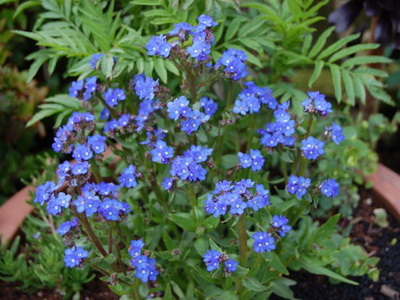
Species and varieties
In total, there are about 4 dozen varieties of ankhuz in the world, among which there are annual and perennial plants that differ in the height of the bush and the color of the buds. The most popular of them are described below.
Anhuza Italian or azure ( Anchusa italica ) – is a tall bush, reaching 80 – 90 cm with straight branching stems covered with sessile narrowed leaves covered with a light pile. Inflorescences loose, racemose, consist of funnel-shaped blue flowers.
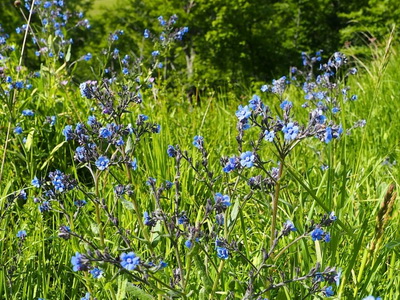
This species begins to bloom in the last spring month, continues until July – August.
Varieties:
“Morning Glory” – an elegant variety with pale blue inflorescences.

‘Loddon Royalis’ is a tall variety reaching just under 1m in height. Flowers blue or azure. Flowering begins in early summer.

‘RovalBlue’ – Valued for the lushness and brightness of the bush, acquired through numerous shoots and fleecy foliage, as well as sky blue buds.
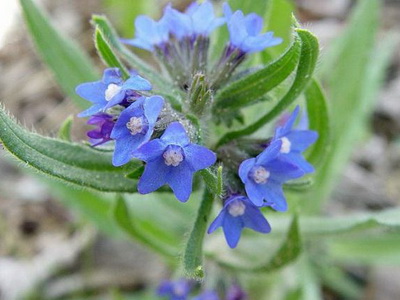
Cape anhuza ( Anchusa capensis ). Differs in strongly branching stems, providing the splendor of the plant. Height is 30 cm. Leaf plates and stems are covered with pile. The inflorescence is racemose, consists of azure hue buds. Their diameter is 12 cm. Flowering lasts from July to October until the onset of cold weather.
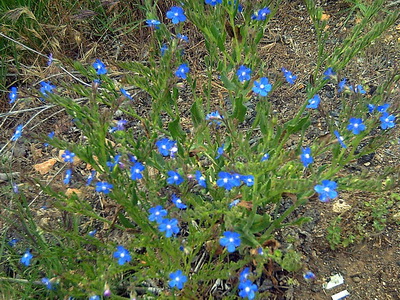
Varieties:
“Alba” – a bush consisting of shoots that begin branching from the bottom. The plant is covered with sessile lanceolate hairy leaves. Flowers are white.
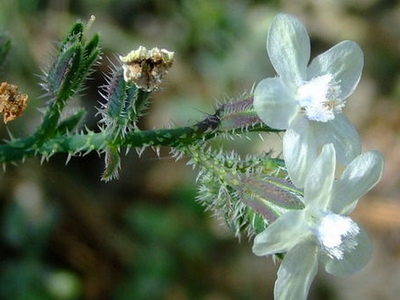
“Blue Angel” – an undersized variety with shoots 25 cm long. The flowers are deep blue in color.

“Blue Bird” – is a sprawling bush about 50 cm high. The inflorescences are dark purple.
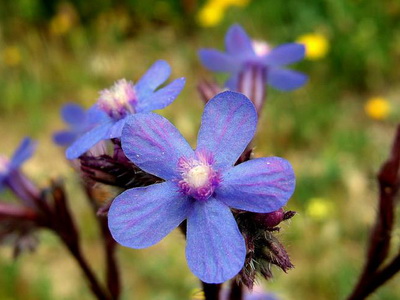
“Dew Drop” is an expressive variety of ankhuz, which is in demand because of the spectacular appearance of the bush, consisting of branching shoots, as well as large deep blue funnel-shaped flowers with a blue central part. The plant reaches 100 – 150 cm.
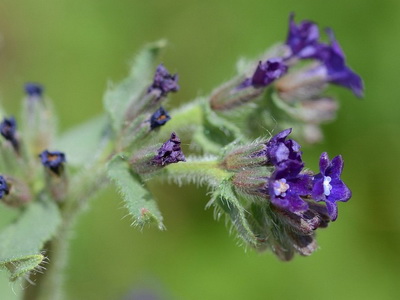
Growing from seed
Volovik is propagated in two ways that have proven to be highly effective: by dividing the bush (if there is an overgrown perennial plant on the site), and with the help of seeds that are collected independently after fruit ripening, or purchased in a store.
In regions with a mild climate, the seeds are immediately planted on the site, having previously prepared the ridges for sowing. This work is carried out in early spring or in October. When sown in spring, sprouts will hatch in April. A month later, they are transplanted to a permanent place. Flowering plants will come in mid-summer.
To grow ankhuz seedlings, the seed is placed in containers filled with a nutrient substrate. Crops are sprayed and covered with foil. They are kept in a room with a temperature of 17 degrees, they regularly monitor the condition of the earthen coma.
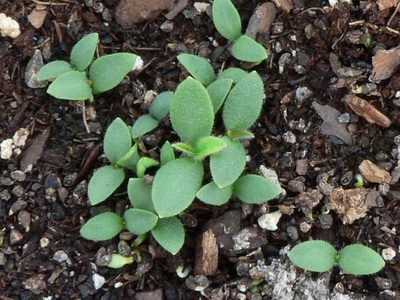
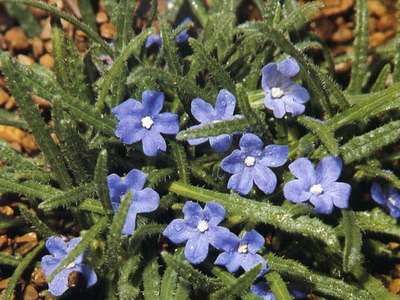
When the top layer dries, watering is carried out. In a month or a little earlier, sprouts will appear. When they have a second or third leaf, they dive into plastic glasses or peat pots. In the second half of May or with the onset of summer, the seedlings are transplanted into open ground, provided that the return frosts have passed.
The division of the bush
Perennial varieties are propagated by dividing the overgrown bush into parts. This work is carried out in the middle or at the end of spring. With the help of a garden pitchfork, a bush is carefully removed from the soil, then the root is divided into several equal parts so that each part of the rhizome and above-ground shoots remain. Slices are sprinkled with crushed coal or ash.
Chalk is also suitable for their treatment from microbes. Seedlings are immediately planted in a permanent place in the garden in pre-prepared holes. Their size should be such that the root system of young plants fits well. After planting, the delenki are watered. After 2 – 3 weeks, the soil around the bushes is enriched with humus.
Breeding features
After planting ankhuz, the gardener must take care of it, since the decorative qualities of the plant will depend on this.
- Location. This culture is recommended to be placed in well-lit beds throughout the day, or in weak partial shade. Getting enough light, the bush will bloom profusely and delight with bright foliage. In gusty winds, the shoots of high varieties of oxen can bend, so after planting, seedlings should immediately be tied to a support.
- The soil. The site where the anhuza will be grown must be fertile, loose, with neutral acidity. Suitable loams and substrates containing humus.
- Watering. Volovik is a drought-resistant plant that does not need frequent moisture. However, with a long absence of rain and high air temperatures, you should water the bush with settled water. It is important to remember that waterlogging the earthy coma threatens to rot the root system and damage parts of the bush with powdery mildew.
- Topdressing. Top dressing should be made after planting, after 14 to 20 days. Perennial specimens are fed during the period of active growth. To do this, use a universal mineral composition for flowering crops. Organic fertilizer in the form of manure or humus is also suitable.
- Other care. Perennial species need shelter for the winter, which is built from spruce branches, straw or dense material. In annual varieties, with the onset of frost, shoots are cut to the ground. Leaves and stems go to compost.
Applying
Ankhuza is a modest in appearance, but in its own way a beautiful plant that has found application in garden landscape design. It is used to create rockeries, alpine peas, and border decorations. Volovik is planted in group plantations, placing next to varieties with different bud colors, but approximately the same length of stems.
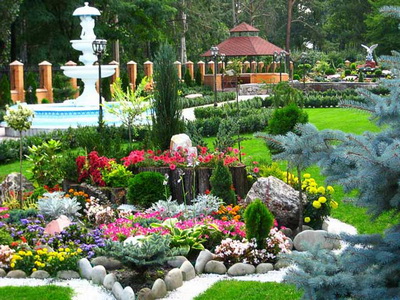
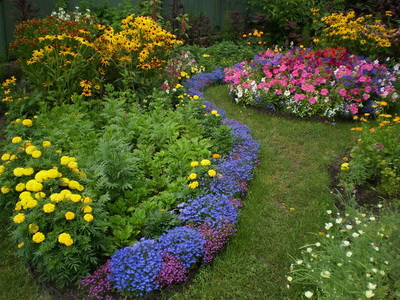
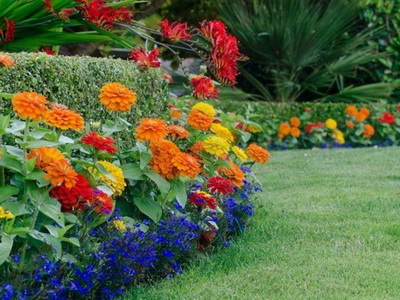
Many ornamental plants, for example, marigolds, iberis, daffodils, irises, flax, primula, cereals, thuja, will harmoniously overtake with an ankhuz flower. Low-growing varieties are grown in containers and pots, exposing them to loggias and terraces with the onset of warm days.







